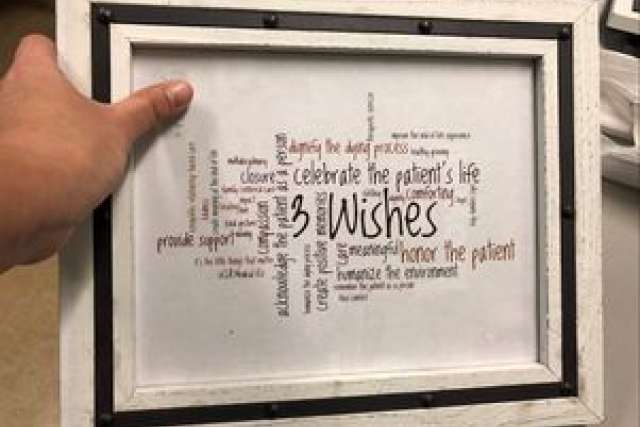After nearly two months in the hospital, there was nothing more that medical science could do to save Adam. The young man lay dying in the intensive care unit connected to the steadily beeping and whirring monitors and life-support machines.
He loved the outdoors, particularly sunsets, and his wife, Sandy, wished he didn’t have to die inside the sterile white walls of his hospital room. Wanting to pay tribute to what he enjoyed, she asked the staff, “Was there a way Adam didn’t have to spend his last moments in an ICU room surrounded by machines?”
Yes, thanks to a new pilot research project in UCLA’s medical intensive care unit.
The concept is simple. The 3 Wishes Project aims to improve the end-of-life experience in the intensive care unit by fulfilling small wishes for dying patients.
“We try to elicit and implement wishes that make the dying process more individualized and dignified,” said Dr. Thanh Neville, an assistant professor in the division of pulmonary and critical care in the David Geffen School of Medicine at UCLA. “And, by honoring the patient’s life and creating a positive memory, we can help support family during an extremely difficult time.”
Dr. Deborah Cook, an intensive care physician in Canada, introduced the 3 Wishes Demonstration Project in St. Joseph’s Healthcare in Ontario in 2013 and it has since expanded to six other Canadian hospitals.
Sherry Xu and Dr. Thanh Neville
Ronald Reagan UCLA Medical Center is the first hospital in the U.S. to adopt the program.
Neville and Dr. Peter Phung, a palliative care physician at UCLA, launched the program after receiving a $10,000 grant from the California State University Institute for Palliative Care. They received additional funds from Vitas Hospice, philanthropist Ronald Katz and other donors who believe in the mission to improve the end-of-life experience.
Since its inception in December 2017, the project has granted the wishes of more than 40 people.
Granting a wish
“Nurses have always done little things to help facilitate special requests for patients,” said Sherry Xu, nursing director in the medical intensive care unit at UCLA. “But now it’s a formal collaboration under the 3 Wishes Project and that creates buy-in when we need to work across different disciplines.”
Once it is accepted that death is imminent — the person has a greater than 95 percent chance of dying in the intensive care unit or there are already plans to remove life support in anticipation of death — the ICU team introduces the 3 Wishes Project as a way to honor the person in the dying process. Requests have included: bringing a harpist to play classical music as a person neared death, personalizing the patient’s room with photos, music, and lighting, and creating keepsakes such as thumbprint keychains or framed Word Clouds. The average cost per patient has been just $30.
“At the very end of life, it’s really the small things that matter,” Neville said.
Clinicians also benefit from the wish process
Although the medical intensive care unit is where many lives are saved, about 20 percent of the time it’s also the place where end-of-life care is delivered. These people have battled illnesses such as cancer, respiratory failure, infections or complications after transplants.
“It can be very stressful to see our patients struggling and the emotional toll it takes on family,” Xu said. “When the staff can help honor the person, it brings a sense of relief and helps us cope with their dying process too.”
Neville and Phung are conducting a study to evaluate the impact of the 3 Wishes Project at UCLA. They interview family members after the person’s death and survey clinicians to ask if the project interrupts work flow, improves morale and how to improve it. So far, every person they’ve asked about their experiences with the program said it should be continued. They have even suggested expanding it to other intensive care units within the UCLA Health system, earlier implementation, and more visibility of the program to the public as a valuable resource.
Eventually, if they can secure more funding, they would like to expand the program to UCLA Health’s other units and hospitals. Neville would also like to study 3 Wishes as a tool to refocus care on values and preferences of people in the intensive care unit patients who are not imminently dying. Philanthropist Arnold Porath has recently agreed to fund such a pilot study.
Final wish granted
On the day Adam was to be removed from life support, the team worked with several departments at the hospital to arrange the task of moving his bed, IV poles, mechanical ventilator, and oxygen tanks through the hallways and onto the hospital’s fourth-floor outdoor terrace.
Surrounded by nurses, respiratory therapists, doctors and immediate family, Sandy lay next to her husband in his bed. Neville brought her a cozy blanket as the air turned chilly.
The breathing tube connecting Adam to the ventilator was removed and Adam passed away peacefully, as the sun began to set.
For more information
To learn more about the 3 Wishes Project, email [email protected] or visit giving.ucla.edu/3WishesProgram.



